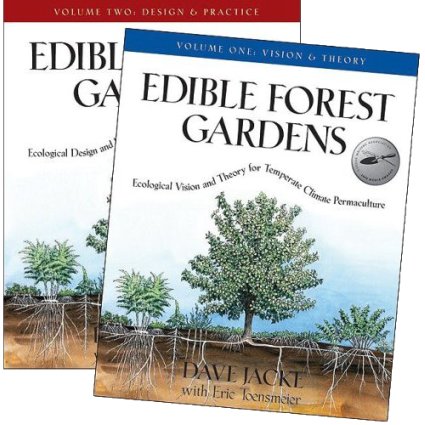
In Anastasia's vision of a Home she provides a brief explanation of how to grow an edible forest garden, and with just that information one could be grown. However, for those looking for a detailed reference, you need look no further than the "Edible Forest Gardens (2 volume set)".
The author, Dave Jacke, has also set up a web site with plenty of information to get you started. Here is an excerpt introducing his vision.

Picture yourself in a forest where almost everything around you is food. Mature and maturing fruit and nut trees form an open canopy. If you look carefully, you can see fruits swelling on many branches—pears, apples, persimmons, pecans, and chestnuts. Shrubs fill the gaps in the canopy. They bear raspberries, blueberries, currants, hazelnuts, and other lesser-known fruits, flowers, and nuts at different times of the year. Assorted native wildflowers, wild edibles, herbs, and perennial vegetables thickly cover the ground. You use many of these plants for food or medicine. Some attract beneficial insects, birds, and butterflies. Others act as soil builders, or simply help keep out weeds. Here and there vines climb on trees, shrubs, or arbors with fruit hanging through the foliage—hardy kiwis, grapes, and passionflower fruits. In sunnier glades large stands of Jerusalem artichokes grow together with groundnut vines. These plants support one another as they store energy in their roots for later harvest and winter storage. Their bright yellow and deep violet flowers enjoy the radiant warmth from the sky. This is an edible forest garden.
What is Edible Forest Gardening?
Edible forest gardening is the art and science of putting plants together in woodlandlike patterns that forge mutually beneficial relationships, creating a garden ecosystem that is more than the sum of its parts. You can grow fruits, nuts, vegetables, herbs, mushrooms, other useful plants, and animals in a way that mimics natural ecosystems. You can create a beautiful, diverse, high-yield garden. If designed with care and deep understanding of ecosystem function, you can also design a garden that is largely self-maintaining. In many of the world's temperate-climate regions, your garden would soon start reverting to forest if you were to stop managing it. We humans work hard to hold back succession—mowing, weeding, plowing, and spraying. If the successional process were the wind, we would be constantly motoring against it. Why not put up a sail and glide along with the land's natural tendency to grow trees? By mimicking the structure and function of forest ecosystems we can gain a number of benefits.
Why Grow an Edible Forest Garden?
While each forest gardener will have unique design goals, forest gardening in general has three primary practical intentions:
These three goals are mutually reinforcing. For example, diverse crops make it easier to design a healthy, self-maintaining ecosystem, and a healthy garden ecosystem should have reduced maintenance requirements. However, forest gardening also has higher aims.
- High yields of diverse products such as food, fuel, fiber, fodder, fertilizer, 'farmaceuticals' and fun;
- A largely self-maintaining garden and;
- A healthy ecosystem.
As Masanobu Fukuoka once said, "The ultimate goal of farming is not the growing of crops, but the cultivation and perfection of human beings." How we garden reflects our worldview. The ultimate goal of forest gardening is not only the growing of crops, but the cultivation and perfection of new ways of seeing, of thinking, and of acting in the world. Forest gardening gives us a visceral experience of ecology in action, teaching us how the planet works and changing our self-perceptions. Forest gardening helps us take our rightful place as part of nature doing nature's work, rather than as separate entities intervening in and dominating the natural world.
Where Can You Grow an Edible Forest Garden?
Anyone with a patch of land can grow a forest garden. They've been created in small urban yards and large parks, on suburban lots, and in small plots of rural farms. The smallest we have seen was a 30 by 50 foot (9 by 15 m) embankment behind an urban housing project, and smaller versions are definitely possible. The largest we have seen spanned 2 acres in a rural research garden. Forest gardeners are doing their thing at 7,000 feet (2,100 m) of elevation in the Rocky Mountains, on the coastal plain of the mid-Atlantic, and in chilly New Hampshire and Vermont. Forest gardening has a long history in the tropics, where there is evidence of the practice extending over 1,500 years. While you can grow a forest garden in almost any climate, it is easiest if you do it in a regions where the native vegetation is forest, especially deciduous forest.
Edible forest gardening is not necessarily gardening in the forest, it is gardening like the forest. You don't need to have an existing woodland if you want to forest garden, though you can certainly work with one. Forest gardeners use the forest as a design metaphor, a model of structure and function, while adapting the design to focus on meeting human needs in a small space. While you can forest garden if you have a shady site, it is best if your garden site has good sun if you want the highest yields of fruits, nuts, berries, and most other products. Edible forest gardening is about expanding the horizons of our food gardening across the full range of the successional sequence, from field to forest, and everything in between.
In Volume One: Vision and Theory, there is a list of the "Top 100" forest garden plants, so over many future posts I will present a description of all of those plants.


No comments:
Post a Comment